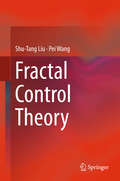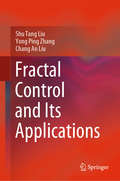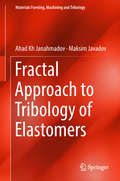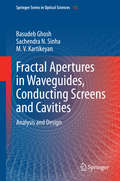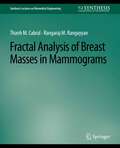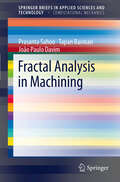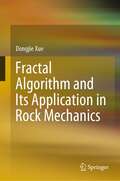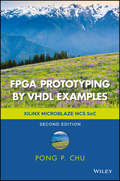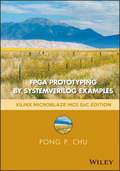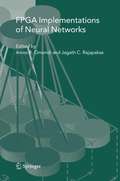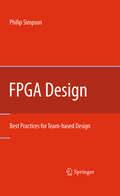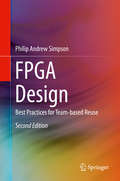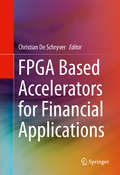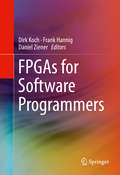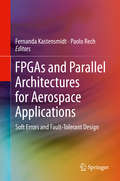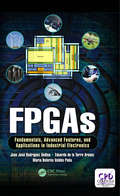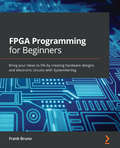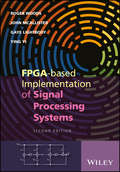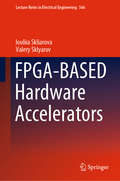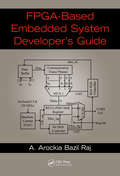- Table View
- List View
Fractal Control Theory
by Shu-Tang Liu Pei WangThis book focuses on the control of fractal behaviors in nonlinear dynamics systems, addressing both the principles and purposes of control. For fractals in different systems, it presents revealing studies on the theory and applications of control, reflecting a spectrum of different control methods used with engineering technology. As such, it will benefit researchers, engineers, and graduate students in fields of fractals, chaos, engineering, etc.
Fractal Control and Its Applications
by Shu Tang Liu Yong Ping Zhang Chang An LiuThe book focuses on fractal control and applications in various fields. Fractal phenomena occur in nonlinear models, and since the behaviors depicted by fractals need to be controlled in practical applications, an understanding of fractal control is necessary. This book introduces readers to Julia set fractals and Mandelbrot set fractals in a range of models, such as physical systems, biological systems and SIRS models, and discusses controllers designed to control these fractals. Further, it demonstrates how the fractal dimension can be calculated in order to describe the complexity of various systems.Offering a comprehensive and systematic overview of the practical issues in fractal control, this book is a valuable resource for readers interested in practical solutions in fractal control. It will also appeal to researchers, engineers, and graduate students in fields of fractal control and applications, as well as chaos control and applications.
Fractal Approach to Tribology of Elastomers (Materials Forming, Machining and Tribology)
by Ahad Kh Janahmadov Maksim JavadovThis book summarizes the results of years of research on the problem of strength and fracture of polymers and elastomers. It sets out the modern approach to the strength theory from the standpoint of fractals, the kinetic and thermodynamic theories as well as the meso-mechanic destruction. The dimension reduction method is applied to model the friction processes in elastomers subjected to the complex dynamic loading. Finally, it analyses a relation between the fracture mechanism and the relation phenomena, and provides new experimental data on the sealing nodes in accordance with their specific working conditions where the effect of self-sealing is observed.
Fractal Apertures in Waveguides, Conducting Screens and Cavities: Analysis and Design (Springer Series in Optical Sciences #187)
by Basudeb Ghosh Sachendra N. Sinha M. V. KartikeyanThis book deals with the design and analysis of fractal apertures in waveguides, conducting screens and cavities using numerical electromagnetics and field-solvers. The aim is to obtain design solutions with improved accuracy for a wide range of applications. To achieve this goal, a few diverse problems are considered. The book is organized with adequate space dedicated for the design and analysis of fractal apertures in waveguides, conducting screens and cavities, microwave/millimeter wave applications followed by detailed case-study problems to infuse better insight and understanding of the subject. Finally, summaries and suggestions are given for future work.Fractal geometries were widely used in electromagnetics, specifically for antennas and frequency selective surfaces (FSS). The self-similarity of fractal geometry gives rise to a multiband response, whereas the space-filling nature of the fractal geometries makes it an efficient element in antenna and FSS unit cell miniaturization. Until now, no efforts were made to study the behavior of these fractal geometries for aperture coupling problems. The aperture coupling problem is an important boundary value problem in electromagnetics and used in waveguide filters and power dividers, slotted ground planes, frequency selective surfaces and metamaterials. The present book is intended to initiate a study of the characteristics of fractal apertures in waveguides, conducting screens and cavities.To perform a unified analysis of these entirely dissimilar problems, the “generalized network formulation of the aperture problems” by Mautz and Harrington was extended to multiple-aperture geometry. The authors consider the problem of coupling between two arbitrary regions coupled together via multiple apertures of arbitrary shape. MATLAB codes were developed for the problems and validated with the results available in the literature as well as through simulations on ANSOFT's HFSS.
Fractal Analysis of Breast Masses in Mammograms (Synthesis Lectures on Biomedical Engineering)
by Thanh Cabral Rangaraj RangayyanFractal analysis is useful in digital image processing for the characterization of shape roughness and gray-scale texture or complexity. Breast masses present shape and gray-scale characteristics in mammograms that vary between benign masses and malignant tumors. This book demonstrates the use of fractal analysis to classify breast masses as benign masses or malignant tumors based on the irregularity exhibited in their contours and the gray-scale variability exhibited in their mammographic images. A few different approaches are described to estimate the fractal dimension (FD) of the contour of a mass, including the ruler method, box-counting method, and the power spectral analysis (PSA) method. Procedures are also described for the estimation of the FD of the gray-scale image of a mass using the blanket method and the PSA method. To facilitate comparative analysis of FD as a feature for pattern classification of breast masses, several other shape features and texture measures are described in the book. The shape features described include compactness, spiculation index, fractional concavity, and Fourier factor. The texture measures described are statistical measures derived from the gray-level cooccurrence matrix of the given image. Texture measures reveal properties about the spatial distribution of the gray levels in the given image; therefore, the performance of texture measures may be dependent on the resolution of the image. For this reason, an analysis of the effect of spatial resolution or pixel size on texture measures in the classification of breast masses is presented in the book. The results demonstrated in the book indicate that fractal analysis is more suitable for characterization of the shape than the gray-level variations of breast masses, with area under the receiver operating characteristics of up to 0.93 with a dataset of 111 mammographic images of masses. The methods and results presented in the book are useful for computer-aided diagnosis of breast cancer. Table of Contents: Computer-Aided Diagnosis of Breast Cancer / Detection and Analysis of\newline Breast Masses / Datasets of Images of Breast Masses / Methods for Fractal Analysis / Pattern Classification / Results of Classification of Breast Masses / Concluding Remarks
Fractal Analysis in Machining (SpringerBriefs in Applied Sciences and Technology)
by Prasanta Sahoo Tapan Barman J. Paulo DavimThe concept of fractals is often considered to describe surface roughness. Fractals retain all the structural information and are characterized by a single descriptor, the fractal dimension, D. Fractal dimension is an intrinsic property of the surface and independent of the filter processing of measuring instrument as well as the sampling length scale. This book cover fractal analysis of surface roughness in different machining processes such as Computer Numeric Control (CNC) end milling, CNC turning, electrical discharge machining and cylindrical grinding. The content here presented adds a significant contribution to the existing literature, with interest to both industrial and academic public.
Fractal Algorithm and Its Application in Rock Mechanics
by Dongjie XueThis book focuses on learning and adapting nonlinear geometry tool in rock engineering through fractal theories, hypotheses, algorithm, practical understandings, and case studies. Understanding self-similarity and self-affinity is a prerequisite to the fractal model in rock mechanics. The book aims to provide a guide for the readers seeking to understand and build nonlinear model by fractal algorithm. The book is motivated by recent rapid advances in rock engineering in China including application of fractal theory, in addition to percolation theory. It is an essential reference to the most promising innovative rock engineering. Chapters are carefully developed to cover (1) new fractal algorithms (2) five engineering cases. This authored book addresses the issue with a holistic and systematic approach that utilizes fractal theory to nonlinear behavior in rock engineering. The book is written for researchers interested in rock and geological engineering as well as organizations engaged in underground energy practices.
Fracking and the Environment: A scientific assessment of the environmental risks from hydraulic fracturing and fossil fuels
by Daniel J. SoederThis book provides a systematic scientific approach to the understanding of hydraulic fracturing (fracking) as a hydrocarbon extraction technology and its impact on the environment. The book addresses research from the past decade to assess how fracking can affect air, water, landscapes and ecosystems, and presents the subject in the context of the history of fracking and shale gas development in the United States, describing what is known and not known about environmental impacts, and the broader implications of fossil energy use, climate change, and technology development. In 9 chapters, the author lays out how and why hydraulic fracturing was developed, what driving forces existed at the beginning of the so-called "shale revolution", how success was achieved, and when and why public acceptance of the technology changed. The intended audience is scientific people who are concerned about fracking, but perhaps do not know all that much about it. It is also intended for lay people who would be interested in understanding the technical details of the process and what effects it might or might not be having on the environment. The book is written at a level that is both understandable and technically correct. A further goal is to give some useful insights even to experienced petroleum geologists and engineers who have been doing fracking for many years.
FPGA Prototyping by VHDL Examples: Xilinx MicroBlaze MCS SoC
by Pong P. ChuA hands-on introduction to FPGA prototyping and SoC design This Second Edition of the popular book follows the same “learning-by-doing” approach to teach the fundamentals and practices of VHDL synthesis and FPGA prototyping. It uses a coherent series of examples to demonstrate the process to develop sophisticated digital circuits and IP (intellectual property) cores, integrate them into an SoC (system on a chip) framework, realize the system on an FPGA prototyping board, and verify the hardware and software operation. The examples start with simple gate-level circuits, progress gradually through the RT (register transfer) level modules, and lead to a functional embedded system with custom I/O peripherals and hardware accelerators. Although it is an introductory text, the examples are developed in a rigorous manner, and the derivations follow strict design guidelines and coding practices used for large, complex digital systems. The new edition is completely updated. It presents the hardware design in the SoC context and introduces the hardware-software co-design concept. Instead of treating examples as isolated entities, the book integrates them into a single coherent SoC platform that allows readers to explore both hardware and software “programmability” and develop complex and interesting embedded system projects. The revised edition: Adds four general-purpose IP cores, which are multi-channel PWM (pulse width modulation) controller, I2C controller, SPI controller, and XADC (Xilinx analog-to-digital converter) controller. Introduces a music synthesizer constructed with a DDFS (direct digital frequency synthesis) module and an ADSR (attack-decay-sustain-release) envelop generator. Expands the original video controller into a complete stream-based video subsystem that incorporates a video synchronization circuit, a test pattern generator, an OSD (on-screen display) controller, a sprite generator, and a frame buffer. Introduces basic concepts of software-hardware co-design with Xilinx MicroBlaze MCS soft-core processor. Provides an overview of bus interconnect and interface circuit. Introduces basic embedded system software development. Suggests additional modules and peripherals for interesting and challenging projects. The FPGA Prototyping by VHDL Examples, Second Edition makes a natural companion text for introductory and advanced digital design courses and embedded system course. It also serves as an ideal self-teaching guide for practicing engineers who wish to learn more about this emerging area of interest.
FPGA Prototyping by VHDL Examples: Xilinx MicroBlaze MCS SoC
by Pong P. ChuA hands-on introduction to FPGA prototyping and SoC design This Second Edition of the popular book follows the same “learning-by-doing” approach to teach the fundamentals and practices of VHDL synthesis and FPGA prototyping. It uses a coherent series of examples to demonstrate the process to develop sophisticated digital circuits and IP (intellectual property) cores, integrate them into an SoC (system on a chip) framework, realize the system on an FPGA prototyping board, and verify the hardware and software operation. The examples start with simple gate-level circuits, progress gradually through the RT (register transfer) level modules, and lead to a functional embedded system with custom I/O peripherals and hardware accelerators. Although it is an introductory text, the examples are developed in a rigorous manner, and the derivations follow strict design guidelines and coding practices used for large, complex digital systems. The new edition is completely updated. It presents the hardware design in the SoC context and introduces the hardware-software co-design concept. Instead of treating examples as isolated entities, the book integrates them into a single coherent SoC platform that allows readers to explore both hardware and software “programmability” and develop complex and interesting embedded system projects. The revised edition: Adds four general-purpose IP cores, which are multi-channel PWM (pulse width modulation) controller, I2C controller, SPI controller, and XADC (Xilinx analog-to-digital converter) controller. Introduces a music synthesizer constructed with a DDFS (direct digital frequency synthesis) module and an ADSR (attack-decay-sustain-release) envelop generator. Expands the original video controller into a complete stream-based video subsystem that incorporates a video synchronization circuit, a test pattern generator, an OSD (on-screen display) controller, a sprite generator, and a frame buffer. Introduces basic concepts of software-hardware co-design with Xilinx MicroBlaze MCS soft-core processor. Provides an overview of bus interconnect and interface circuit. Introduces basic embedded system software development. Suggests additional modules and peripherals for interesting and challenging projects. The FPGA Prototyping by VHDL Examples, Second Edition makes a natural companion text for introductory and advanced digital design courses and embedded system course. It also serves as an ideal self-teaching guide for practicing engineers who wish to learn more about this emerging area of interest.
FPGA Prototyping by SystemVerilog Examples: Xilinx MicroBlaze MCS SoC Edition
by Pong P. ChuA hands-on introduction to FPGA prototyping and SoC design This is the successor edition of the popular FPGA Prototyping by Verilog Examples text. It follows the same “learning-by-doing” approach to teach the fundamentals and practices of HDL synthesis and FPGA prototyping. The new edition uses a coherent series of examples to demonstrate the process to develop sophisticated digital circuits and IP (intellectual property) cores, integrate them into an SoC (system on a chip) framework, realize the system on an FPGA prototyping board, and verify the hardware and software operation. The examples start with simple gate-level circuits, progress gradually through the RT (register transfer) level modules, and lead to a functional embedded system with custom I/O peripherals and hardware accelerators. Although it is an introductory text, the examples are developed in a rigorous manner, and the derivations follow the strict design guidelines and coding practices used for large, complex digital systems. The book is completely updated and uses the SystemVerilog language, which “absorbs” the Verilog language. It presents the hardware design in the SoC context and introduces the hardware-software co-design concept. Instead of treating examples as isolated entities, the book integrates them into a single coherent SoC platform that allows readers to explore both hardware and software “programmability” and develop complex and interesting embedded system projects. The new edition: Adds four general-purpose IP cores, which are multi-channel PWM (pulse width modulation) controller, I2C controller, SPI controller, and XADC (Xilinx analog-to-digital converter) controller. Introduces a music synthesizer constructed with a DDFS (direct digital frequency synthesis) module and an ADSR (attack-decay-sustain-release) envelope generator. Expands the original video controller into a complete stream based video subsystem that incorporates a video synchronization circuit, a test-pattern generator, an OSD (on-screen display) controller, a sprite generator, and a frame buffer. Provides a detailed discussion on blocking and nonblocking statements and coding styles. Describes basic concepts of software-hardware co-design with Xilinx MicroBlaze MCS soft-core processor. Provides an overview of bus interconnect and interface circuit. Presents basic embedded system software development. Suggests additional modules and peripherals for interesting and challenging projects. FPGA Prototyping by SystemVerilog Examples makes a natural companion text for introductory and advanced digital design courses and embedded system courses. It also serves as an ideal self-teaching guide for practicing engineers who wish to learn more about this emerging area of interest.
FPGA Prototyping by SystemVerilog Examples: Xilinx MicroBlaze MCS SoC Edition
by Pong P. ChuA hands-on introduction to FPGA prototyping and SoC design This is the successor edition of the popular FPGA Prototyping by Verilog Examples text. It follows the same “learning-by-doing” approach to teach the fundamentals and practices of HDL synthesis and FPGA prototyping. The new edition uses a coherent series of examples to demonstrate the process to develop sophisticated digital circuits and IP (intellectual property) cores, integrate them into an SoC (system on a chip) framework, realize the system on an FPGA prototyping board, and verify the hardware and software operation. The examples start with simple gate-level circuits, progress gradually through the RT (register transfer) level modules, and lead to a functional embedded system with custom I/O peripherals and hardware accelerators. Although it is an introductory text, the examples are developed in a rigorous manner, and the derivations follow the strict design guidelines and coding practices used for large, complex digital systems. The book is completely updated and uses the SystemVerilog language, which “absorbs” the Verilog language. It presents the hardware design in the SoC context and introduces the hardware-software co-design concept. Instead of treating examples as isolated entities, the book integrates them into a single coherent SoC platform that allows readers to explore both hardware and software “programmability” and develop complex and interesting embedded system projects. The new edition: Adds four general-purpose IP cores, which are multi-channel PWM (pulse width modulation) controller, I2C controller, SPI controller, and XADC (Xilinx analog-to-digital converter) controller. Introduces a music synthesizer constructed with a DDFS (direct digital frequency synthesis) module and an ADSR (attack-decay-sustain-release) envelope generator. Expands the original video controller into a complete stream based video subsystem that incorporates a video synchronization circuit, a test-pattern generator, an OSD (on-screen display) controller, a sprite generator, and a frame buffer. Provides a detailed discussion on blocking and nonblocking statements and coding styles. Describes basic concepts of software-hardware co-design with Xilinx MicroBlaze MCS soft-core processor. Provides an overview of bus interconnect and interface circuit. Presents basic embedded system software development. Suggests additional modules and peripherals for interesting and challenging projects. FPGA Prototyping by SystemVerilog Examples makes a natural companion text for introductory and advanced digital design courses and embedded system courses. It also serves as an ideal self-teaching guide for practicing engineers who wish to learn more about this emerging area of interest.
FPGA Implementations of Neural Networks
by Amos R. Omondi Jagath C. RajapakseDuring the 1980s and early 1990s there was signi?cant work in the design and implementation of hardware neurocomputers. Nevertheless, most of these efforts may be judged to have been unsuccessful: at no time have have ha- ware neurocomputers been in wide use. This lack of success may be largely attributed to the fact that earlier work was almost entirely aimed at developing custom neurocomputers, based on ASIC technology, but for such niche - eas this technology was never suf?ciently developed or competitive enough to justify large-scale adoption. On the other hand, gate-arrays of the period m- tioned were never large enough nor fast enough for serious arti?cial-neur- network (ANN) applications. But technology has now improved: the capacity and performance of current FPGAs are such that they present a much more realistic alternative. Consequently neurocomputers based on FPGAs are now a much more practical proposition than they have been in the past. This book summarizes some work towards this goal and consists of 12 papers that were selected, after review, from a number of submissions. The book is nominally divided into three parts: Chapters 1 through 4 deal with foundational issues; Chapters 5 through 11 deal with a variety of implementations; and Chapter 12 looks at the lessons learned from a large-scale project and also reconsiders design issues in light of current and future technology.
FPGA Design: Best Practices for Team-based Design
by Philip SimpsonIn August of 2006, an engineering VP from one of Altera’s customers approached Misha Burich, VP of Engineering at Altera, asking for help in reliably being able to predict the cost, schedule and quality of system designs reliant on FPGA designs. At this time, I was responsible for defining the design flow requirements for the Altera design software and was tasked with investigating this further. As I worked with the customer to understand what worked and what did not work reliably in their FPGA design process, I noted that this problem was not unique to this one customer. The characteristics of the problem are shared by many Corporations that implement designs in FPGAs. The Corporation has many design teams at different locations and the success of the FPGA projects vary between the teams. There is a wide range of design experience across the teams. There is no working process for sharing design blocks between engineering teams. As I analyzed the data that I had received from hundreds of customer visits in the past, I noticed that design reuse among engineering teams was a challenge. I also noticed that many of the design teams at the same Companies and even within the same design team used different design methodologies. Altera had recently solved this problem as part of its own FPGA design software and IP development process.
FPGA Design: Best Practices for Team-based Reuse
by Philip Andrew SimpsonThis book describes best practices for successful FPGA design. It is the result of the author’s meetings with hundreds of customers on the challenges facing each of their FPGA design teams. By gaining an understanding into their design environments, processes, what works and what does not work, key areas of concern in implementing system designs have been identified and a recommended design methodology to overcome these challenges has been developed.This book’s content has a strong focus on design teams that are spread across sites. The goal being to increase the productivity of FPGA design teams by establishing a common methodology across design teams; enabling the exchange of design blocks across teams.Coverage includes the complete FPGA design flow, from the basics to advanced techniques. This new edition has been enhanced to include new sections on System modeling, embedded design and high level design. The original sections on Design Environment, RTL design and timing closure have all been expanded to include more up to date techniques as well as providing more extensive scripts and RTL code that can be reused by readers.Presents complete, field-tested methodology for FPGA design, focused on reuse across design teams;Offers best practices for FPGA timing closure, in-system debug, and board design;Details techniques to resolve common pitfalls in designing with FPGAs.
FPGA Based Accelerators for Financial Applications
by Christian SchryverThis book covers the latest approaches and results from reconfigurable computing architectures employed in the finance domain. So-called field-programmable gate arrays (FPGAs) have already shown to outperform standard CPU- and GPU-based computing architectures by far, saving up to 99% of energy depending on the compute tasks. Renowned authors from financial mathematics, computer architecture and finance business introduce the readers into today’s challenges in finance IT, illustrate the most advanced approaches and use cases and present currently known methodologies for integrating FPGAs in finance systems together with latest results. The complete algorithm-to-hardware flow is covered holistically, so this book serves as a hands-on guide for IT managers, researchers and quants/programmers who think about integrating FPGAs into their current IT systems.
FPGAs for Software Programmers
by Dirk Koch Frank Hannig Daniel ZienerThis book makes powerful Field Programmable Gate Array (FPGA) and reconfigurable technology accessible to software engineers by covering different state-of-the-art high-level synthesis approaches (e.g., OpenCL and several C-to-gates compilers). It introduces FPGA technology, its programming model, and how various applications can be implemented on FPGAs without going through low-level hardware design phases. Readers will get a realistic sense for problems that are suited for FPGAs and how to implement them from a software designer’s point of view. The authors demonstrate that FPGAs and their programming model reflect the needs of stream processing problems much better than traditional CPU or GPU architectures, making them well-suited for a wide variety of systems, from embedded systems performing sensor processing to large setups for Big Data number crunching. This book serves as an invaluable tool for software designers and FPGA design engineers who are interested in high design productivity through behavioural synthesis, domain-specific compilation, and FPGA overlays.Introduces FPGA technology to software developers by giving an overview of FPGA programming models and design tools, as well as various application examples;Provides a holistic analysis of the topic and enables developers to tackle the architectural needs for Big Data processing with FPGAs;Explains the reasons for the energy efficiency and performance benefits of FPGA processing;Provides a user-oriented approach and a sense for where and how to apply FPGA technology.
FPGAs and Parallel Architectures for Aerospace Applications: Soft Errors and Fault-Tolerant Design
by Fernanda Kastensmidt Paolo RechThis book introduces the concepts of soft errors in FPGAs, as well as the motivation for using commercial, off-the-shelf (COTS) FPGAs in mission-critical and remote applications, such as aerospace. The authors describe the effects of radiation in FPGAs, present a large set of soft-error mitigation techniques that can be applied in these circuits, as well as methods for qualifying these circuits under radiation. Coverage includes radiation effects in FPGAs, fault-tolerant techniques for FPGAs, use of COTS FPGAs in aerospace applications, experimental data of FPGAs under radiation, FPGA embedded processors under radiation and fault injection in FPGAs. Since dedicated parallel processing architectures such as GPUs have become more desirable in aerospace applications due to high computational power, GPU analysis under radiation is also discussed.
FPGAs: Fundamentals, Advanced Features, and Applications in Industrial Electronics (Industrial Electronics)
by Juan Jose Andina Eduardo de Arnanz Maria Dolores ValdesField Programmable Gate Arrays (FPGAs) are currently recognized as the most suitable platform for the implementation of complex digital systems targeting an increasing number of industrial electronics applications. They cover a huge variety of application areas, such as: aerospace, food industry, art, industrial automation, automotive, biomedicine, process control, military, logistics, power electronics, chemistry, sensor networks, robotics, ultrasound, security, and artificial vision. This book first presents the basic architectures of the devices to familiarize the reader with the fundamentals of FPGAs before identifying and discussing new resources that extend the ability of the devices to solve problems in new application domains. Design methodologies are discussed and application examples are included for some of these domains, e.g., mechatronics, robotics, and power systems.
FPGAs: Fundamentals, Advanced Features, and Applications in Industrial Electronics (Industrial Electronics)
by Juan Jose Andina Eduardo de Arnanz Maria Dolores ValdesField Programmable Gate Arrays (FPGAs) are currently recognized as the most suitable platform for the implementation of complex digital systems targeting an increasing number of industrial electronics applications. They cover a huge variety of application areas, such as: aerospace, food industry, art, industrial automation, automotive, biomedicine, process control, military, logistics, power electronics, chemistry, sensor networks, robotics, ultrasound, security, and artificial vision. This book first presents the basic architectures of the devices to familiarize the reader with the fundamentals of FPGAs before identifying and discussing new resources that extend the ability of the devices to solve problems in new application domains. Design methodologies are discussed and application examples are included for some of these domains, e.g., mechatronics, robotics, and power systems.
Fpga Programming For Beginners: Bring Your Ideas To Life By Creating Hardware Designs And Electronic Circuits With Systemverilog
by Frank BrunoBring your ideas to life by creating hardware designs and electronic circuits with SystemVerilog
FPGA-based Implementation of Signal Processing Systems
by Roger Woods John McAllister Gaye Lightbody Ying YiAn important working resource for engineers and researchers involved in the design, development, and implementation of signal processing systems The last decade has seen a rapid expansion of the use of field programmable gate arrays (FPGAs) for a wide range of applications beyond traditional digital signal processing (DSP) systems. Written by a team of experts working at the leading edge of FPGA research and development, this second edition of FPGA-based Implementation of Signal Processing Systems has been extensively updated and revised to reflect the latest iterations of FPGA theory, applications, and technology. Written from a system-level perspective, it features expert discussions of contemporary methods and tools used in the design, optimization and implementation of DSP systems using programmable FPGA hardware. And it provides a wealth of practical insights—along with illustrative case studies and timely real-world examples—of critical concern to engineers working in the design and development of DSP systems for radio, telecommunications, audio-visual, and security applications, as well as bioinformatics, Big Data applications, and more. Inside you will find up-to-date coverage of: FPGA solutions for Big Data Applications, especially as they apply to huge data sets The use of ARM processors in FPGAs and the transfer of FPGAs towards heterogeneous computing platforms The evolution of High Level Synthesis tools—including new sections on Xilinx's HLS Vivado tool flow and Altera's OpenCL approach Developments in Graphical Processing Units (GPUs), which are rapidly replacing more traditional DSP systems FPGA-based Implementation of Signal Processing Systems, 2nd Edition is an indispensable guide for engineers and researchers involved in the design and development of both traditional and cutting-edge data and signal processing systems. Senior-level electrical and computer engineering graduates studying signal processing or digital signal processing also will find this volume of great interest.
FPGA-based Implementation of Signal Processing Systems
by Roger Woods John McAllister Gaye Lightbody Ying YiAn important working resource for engineers and researchers involved in the design, development, and implementation of signal processing systems The last decade has seen a rapid expansion of the use of field programmable gate arrays (FPGAs) for a wide range of applications beyond traditional digital signal processing (DSP) systems. Written by a team of experts working at the leading edge of FPGA research and development, this second edition of FPGA-based Implementation of Signal Processing Systems has been extensively updated and revised to reflect the latest iterations of FPGA theory, applications, and technology. Written from a system-level perspective, it features expert discussions of contemporary methods and tools used in the design, optimization and implementation of DSP systems using programmable FPGA hardware. And it provides a wealth of practical insights—along with illustrative case studies and timely real-world examples—of critical concern to engineers working in the design and development of DSP systems for radio, telecommunications, audio-visual, and security applications, as well as bioinformatics, Big Data applications, and more. Inside you will find up-to-date coverage of: FPGA solutions for Big Data Applications, especially as they apply to huge data sets The use of ARM processors in FPGAs and the transfer of FPGAs towards heterogeneous computing platforms The evolution of High Level Synthesis tools—including new sections on Xilinx's HLS Vivado tool flow and Altera's OpenCL approach Developments in Graphical Processing Units (GPUs), which are rapidly replacing more traditional DSP systems FPGA-based Implementation of Signal Processing Systems, 2nd Edition is an indispensable guide for engineers and researchers involved in the design and development of both traditional and cutting-edge data and signal processing systems. Senior-level electrical and computer engineering graduates studying signal processing or digital signal processing also will find this volume of great interest.
FPGA-BASED Hardware Accelerators (Lecture Notes in Electrical Engineering #566)
by Valery Sklyarov Iouliia SkliarovaThis book suggests and describes a number of fast parallel circuits for data/vector processing using FPGA-based hardware accelerators. Three primary areas are covered: searching, sorting, and counting in combinational and iterative networks. These include the application of traditional structures that rely on comparators/swappers as well as alternative networks with a variety of core elements such as adders, logical gates, and look-up tables. The iterative technique discussed in the book enables the sequential reuse of relatively large combinational blocks that execute many parallel operations with small propagation delays. For each type of network discussed, the main focus is on the step-by-step development of the architectures proposed from initial concepts to synthesizable hardware description language specifications. Each type of network is taken through several stages, including modeling the desired functionality in software, the retrieval and automatic conversion of key functions, leading to specifications for optimized hardware modules. The resulting specifications are then synthesized, implemented, and tested in FPGAs using commercial design environments and prototyping boards. The methods proposed can be used in a range of data processing applications, including traditional sorting, the extraction of maximum and minimum subsets from large data sets, communication-time data processing, finding frequently occurring items in a set, and Hamming weight/distance counters/comparators. The book is intended to be a valuable support material for university and industrial engineering courses that involve FPGA-based circuit and system design.
FPGA-Based Embedded System Developer's Guide
by A. Arockia RajThe book covers various aspects of VHDL programming and FPGA interfacing with examples and sample codes giving an overview of VLSI technology, digital circuits design with VHDL, programming, components, functions and procedures, and arithmetic designs followed by coverage of the core of external I/O programming, algorithmic state machine based system design, and real-world interfacing examples. • Focus on real-world applications and peripherals interfacing for different applications like data acquisition, control, communication, display, computing, instrumentation, digital signal processing and top module design • Aims to be a quick reference guide to design digital architecture in the FPGA and develop system with RTC, data transmission protocols
